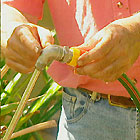Don looked at some practical ways to save water and keep the garden alive and functioning through the drought.
Watering the lawn
If there are water restrictions in your area and you want to conserve water, it doesn’t hurt to let the lawn yellow off a little. Virtually all grasses will recover once they receive moisture at the end of the drought.
Watering trees
You must water your trees during the drought, otherwise they will suffer from stress. When trees are stressed small cracks often appear in the bark, providing entry points for insects and disease. Stressed trees may also drop limbs. Use a sprinkler to water your trees for about one hour per week (dome sprinklers cost around $10, while oscillating and rotating sprinklers cost around $30).
Deep watering device
Don demonstrated a quick and efficient way to deliver water to a plant that is drying out. He used a homemade watering device with a long nozzle, which he inserted into the soil and pushed down in among the roots. To make your own deep watering device for under $20, follow the instructions below.
You will need:
1 metre (or more, depending on your height) x 12mm hard drawn copper pipe
1 x 12mm (No.13) Cu (copper) to MI (male internal thread) elbow
1 female thread hose tap fitting
What to do:
1. Solder the elbow joint to the copper pipe
2. Screw on the hose tap fitting
3. Attach the hose
Water repellent soils
Watering the garden is very difficult if your soil is water repellent (or hydrophobic), because the water just runs off instead of soaking into the soil. These soils can be treated with a soil wetting agent such as Wettasoil ($17 for 1 litre) or SaturAid ($10 for 500g). However, Don found that a thick mulch of stable manure is even more effective. He does not recommend hydro gels or jelly-like substances that you can buy to add to potting mixes, because they tend to break down when they interact with iron in the soil.
Planting and fertilising
Do not put in new plants or fertilise the garden during the drought. Newly planted trees and shrubs may die from heat and lack of water. Plants must be watered well before and after fertilising, but this is difficult to do when there are water restrictions. Wait until autumn or until the rains come, then fertilise established plants and plant new ones.
When to water
Always water the garden early in the morning or in the evening. Watering in the middle of the day is not a good idea, because much of the water evaporates instead of getting to the plants. (If there are water restrictions in your area, you will be asked to only water at specified times.)
Foolproof watering system
Don showed a line of trees along a driveway being watered very effectively without using any spray heads. The system consists of a main line with spaghetti tubes running to each plant. On top of each spaghetti tube a small valve controls the flow of water (see photo). The main tap can be turned on and off by hand, or by a mechanical timer.
This system is cheap, easy and almost foolproof. Blockages are quickly and easily cleared by simply opening the valves, and problems with water flow are so obvious you can spot them driving past in a car! This saves you having to continually walk the length of the line checking the system.
Washing the car
Do not wash your car on the lawn. Driving vehicles of any type onto grassed areas will cause soil compaction, followed by weed growth. If you’re worried about saving water, park your car on concrete or tar in a position where the water runs off onto the grass. The other alternative is to take your car to a car wash that recycles the water.
Mulching
Apply a thick mulch to all your garden beds to help your plants survive the drought. Mulch helps prevent moisture loss from the soil, keeps the soil temperature constant and suppresses weeds.



